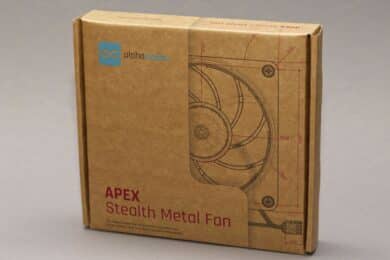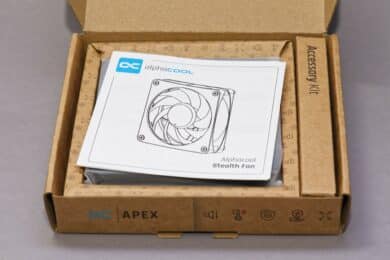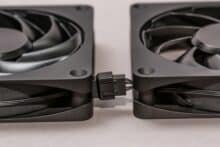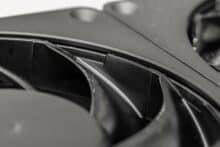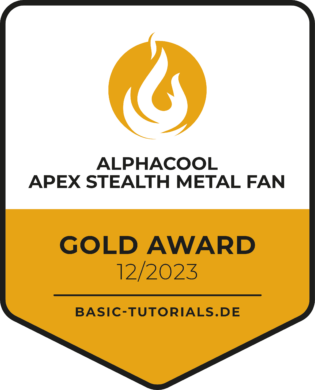
The special features of fans can rarely be summed up as quickly as with the Alphacool APEX Stealth: it has a metal frame. It’s not the first time I’ve come across a fan with a metal frame. Back in 2010, for example, I had a TITAN fan in my computer that was equipped with an aluminum frame – but unfortunately it was not at all convincing in terms of performance. If Alphacool’s marketing is to be believed, the signs are much better for their new 120 mm fans. I will analyze how they perform in terms of performance and noise in this Alphacool APEX Stealth test and also throw other high-priced fans into the ring for comparison.
Specifications
The 3000 RPM version of the fan is tested. Alternatively, a 2000 RPM version is also available, which is only restricted in terms of maximum speed and is instead limited to a tolerable volume.
| Size | 120 x 120 x 25 mm |
| Maximum speed | 3000 RPM |
| Connection | PWM (Male Female) |
| max. volume flow | 199 m³/h |
| max. volume | 49.9 dB(A) |
| max. static pressure | 6.22 mm H2O |
| Expected service life | > 100,000 h (more than 11 years of continuous operation) |
| Warranty period | 5 years |
| Price | Black: € 29.90 * White: € 29.90 * Chrome: € 29.90 * Gold: € 29.90 * |

Packaging and scope of delivery
- Brown packaging with a high cardboard content should be easy to recycle.
- A large number of screws are included as well as a PWM extension cable and a cleaning cloth.
The packaging of the Alphacool APEX Stealth quickly shows that the company has opted for sustainable packaging materials. It is made of brown cardboard and is quite large for a 120 mm fan. When you open the box, which is pleasingly smooth, you can see that the fans are protected against impact by a layer of “cardboard tubes”.
The accessories are also contained in an additional box. In addition to a PWM extension cable, there are three packs of long screws that cover virtually every thread standard in the radiator area. The water cooling specialists at Alphacool have thought ahead! Finally, there is a pack of four small rings in the scope of delivery, which can be used as counterparts for the screws with the M4 thread in order to use the fans as housing fans. Regular fan screws are not included – and rightly so. These usually come with a self-tapping thread, which simply does not work with the die-cast zinc frame of the Alphacool APEX Stealth.
The fan itself is housed in an additional plastic bag that protects it from scratches and fingerprints. Speaking of fingerprints: A small cleaning cloth is also included in the accessory box to get rid of any fingerprints during assembly.

Design
- Four color variants available (matt black, gold, chrome, white)
- Alphacool APEX StealthTest in matt black
- Daisy-chain capability
- Fan blades are connected on the outside to form a ring
The Alphacool APEX Stealth is available in four different colors: chrome-plated, gold-plated, white and – as in our test – classic black. The metal frame is matt black, while the fan blades are a little shinier. There are a total of nine of these, which are joined together at the edges. This concept can also be found in other fans, such as the Cooler Master Mobius (with seven fan blades) or the Arctic P12 Max (with five fan blades). This design has particular advantages in the high-speed range, as the fan blades cannot bend further due to the centrifugal forces. And with a fan with up to 3000 RPM, such as the Alphacool APEX Stealth, this can be quite relevant.
The frame is designed for the standard fan dimensions of 120 x 120 x 25 mm and the metal parts are hollowed out on the inside towards the edge, which on the one hand prevents the rather high weight from becoming too heavy and on the other hand a short cable is laid here – with a male connection at one corner and a female connection at the other. This allows the fans to be connected to each other according to the daisy chain principle and several fans can be used on one connection. As there is virtually no cable from the fan to the outside, you have to use the supplied extension cable to actually connect the fans.
At the rear, the fans have a relatively normal design with five struts from the motor to the frame, with the cable routed quite inconspicuously in one of them. The middle is printed in the usual way for fans, but in gray and not quite as conspicuous. Except for the production date in white.
Build quality
- Extremely high-quality and cleanly finished metal frame
- Plastic fan blades are connected to the tip with a ring
- Thin cables are easy to lay
Yes wow – quite honestly: the metal frame feels extremely high-quality. The look is also clean: there are no sharp edges, no unclean spots in the coating or anything else to be seen. A full-length shaft makes it easier to feed the screw through.
Unlike the frame, the fan blades are made of plastic. “Great, they advertise a metal fan so much and then the most important part is made of plastic” you might think. But to be honest, plastic also has an advantage here – simply because it is lighter. To make metal fan blades so light, they would have had to be made very thin. And then, in all probability, they would have been easy to bend and, unlike plastic, they would have retained their new shape after bending. In short: plastic is simply better suited for fans. Apart from that, of course, the look of the black shade differs from the frame, but there is nothing to complain about in terms of workmanship. The fan blades are therefore cleanly finished.
Instead of rubberized contact surfaces, the Alphacool APEX Stealth relies on internal decoupling. This means that the suspension of the motor is separated from the metal parts of the frame by a vibration-damping layer.
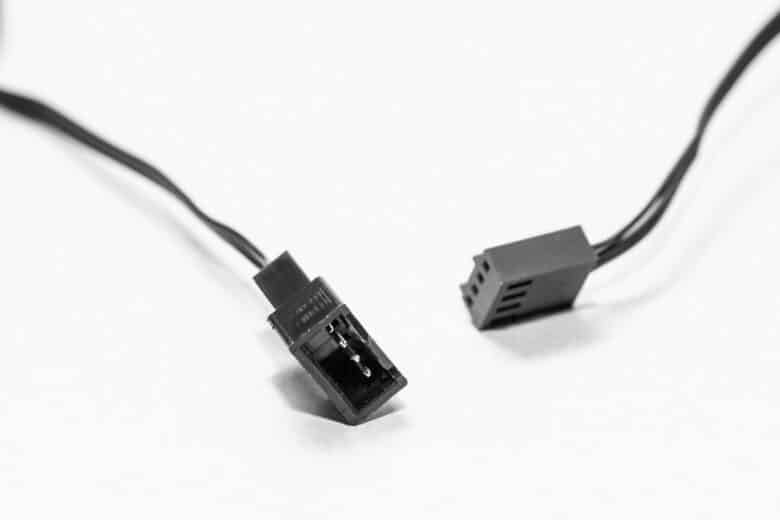
The extension cable, the use of which is virtually mandatory, is thin and black. This makes it inconspicuous and easy to lay. Of course, it is not as well protected as a cable with a sheath, but in the (unlikely) event of a defect, it can also be easily replaced as it is not permanently connected to the fan. Or you can also use other PWM extension cables. Overall, I would have hoped for a somewhat sturdier cable for the solid frame of the fan.
Mounting and control
- Countersunk screws do not protrude over the frame
- Housing assembly somewhat complicated due to individual counterparts
- Screws for all standards included in the scope of delivery
The funnel-shaped notches make it necessary to use the screws supplied. These are shaped accordingly and the heads are sunk into them instead of protruding, which is common with other fans and their screws.

Conveniently, screws for all conceivable thread standards are included. However, if you want to use the Alphacool APEX Stealth on other radiators in the future, you will encounter the problem that the unused screws should be kept in a place where they are easy to find. If you don’t want to keep the entire packaging, you can at least remove the accessory box and store it more compactly.
What still needs to be addressed is the assembly of the housing. As already mentioned, you can’t simply use regular fan screws, as these can’t really cut into the metal frame. Instead, each fan is supplied with four counterparts for the M4 screws. This is therefore a little fiddly, as you have to push the screws through the fan and the housing from the fan side. The small nuts have to be held on the other side and then the screws have to be turned.
Alternatively, you can hold the screws with one finger and turn the small black nuts with your fingers. I found this variant more convenient, especially in tight places, such as behind the air cooler, as I didn’t have to try to reach it with a screwdriver.
Comparison of the fans in the test
- Test on air cooler, radiator and as case fan
- Comparison with three other high-speed fans
For the test, the Alphacool APEX Stealth is used and measured in three scenarios. And of course not just on their own, but in comparison with other fans. I chose three other high-speed fans for this: The be quiet! Silent Wings Pro 4 120mm, the Lian Li Uni Fan P28 and the cheaper Arctic P12 Max. All three fans reach speeds in the 3000 RPM range. The Lian Li fans are a little slower and compensate for this by being 10% thicker. Incidentally, the latter are the only ones to offer daisy-chaining alongside the Alphacool fans. All of the competitors have proven to be fans with high performance, so it won’t be easy to keep up with them.
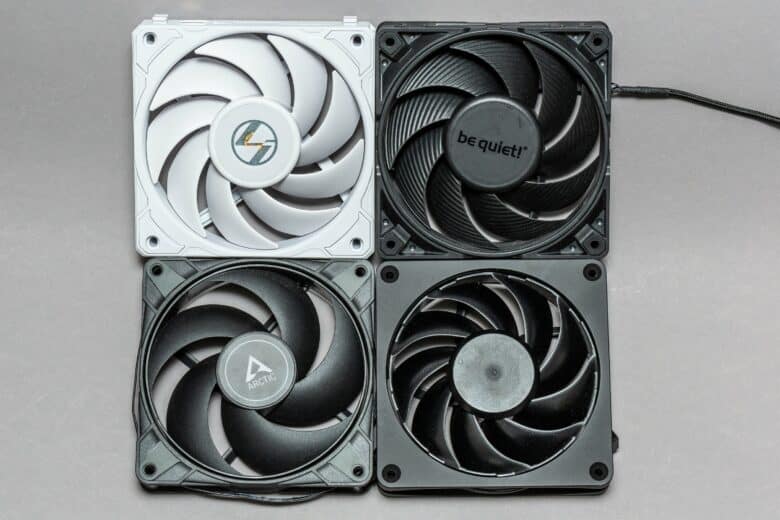
Brief analysis of the build quality: The Alphacool fans appear the cleanest and the metal looks extremely high quality. The be quiet! Silent Wings Pro 4 have a higher quality finish in the fan blade area. The Lian Li Uni Fan P28 is close behind the two top dogs, followed slightly behind by the Arctic P12 Max – not unexpected given the much lower price.
Alphacool APEX Stealth performance and noise test
- Test as a case fan, as a radiator fan and on an air cooler
- Description of the test setups
- Results are given as a difference to room temperature, lower results are better
The three test scenarios include a performance test on a radiator, which will be the primary purpose of the water cooling specialist’s fans. There will also be a test as a housing fan and one on an air cooler. Tests will be carried out once each at 1100 RPM, at full power and at 33 dB(A). This covers three possible settings.

The radiator used is the AIO Arctic Liquid Freezer II 240 on an overclocked Intel i5-9600K, the air cooler is the DeepCool AK400 on an AMD Ryzen 5 3600X and the case is the Fractal Design Pop XL Air.
The results are given as the difference to the room temperature in Kelvin. So if the result is 30 K, you would have to add the room temperature (e.g. 22°C) and arrive at the measured temperature – 52°C in this example. The lower, the better.
Test on the radiator
- Good performance
- Unfortunately a little weaker overall than the competition
- A more present noise at lower speeds than other similarly priced fans
| 1100 RPM | 33 dB(A) | 100% performance | |
| Alphacool APEX Stealth |
47 K | 45 K (1460 RPM) |
43 K 50.7 dB(A) (3000 RPM) |
| be quiet! Silent Wings Pro 4 |
46 K | 44 K (1650 RPM) |
42,5 K 47 dB(A) (2700 RPM) |
| Arctic P12 Max |
47 K | 44 K (1750 RPM) |
42 K 50 dB(A) (3100 RPM) |
| Lian Li Uni Fan P28 |
46 K | 43,5 K (1600 RPM) |
41,5 K 45.8 dB(A) (2560 RPM) |
Well… on the positive side, the performance of the Alphacool APEX Stealth is quite good. On the negative side, they are beaten by all the fans included in the comparison. The fans from be quiet! are similarly or slightly more expensive. The Lian Li Uni Fan P28 is a little cheaper and the Arctic P12 Max, which performed most similarly on the radiator of my test setup, is significantly cheaper. The best fans in this scenario were the Lian Li.

At 1100 RPM, I have not mentioned any volume here, as all the fans were too quiet for the measuring device in comparison. Subjectively, however, I was able to judge the approximate sound characteristics. The be quiet! fans had the most pleasant sound in this comparison and were barely perceptible. The Lian Li was perceptible as a slight, unobtrusive hiss. A kind of “bearing grinding” was perceptible with the Arctic P12 Max and a quiet, mid-frequency “whistling” with the Alphacool. This means that the Arctic and Alphacool fans in particular suffer from typical “high-speed fan diseases”. It is therefore quite possible – without being able to check it – that the 2000 RPM version of the Alphacool APEX Stealth is also slightly quieter at lower speeds.

Alphacool APEX Stealth as a case fan
- High speed possible due to good running smoothness
- Slightly weaker than the comparison fans, but not far behind
- Low noise level ensures higher possible speed
| 1100 RPM | 33 dB(A) | 100% performance | |
| Alphacool APEX Stealth |
37 K (CPU) 30.5 K (GPU) |
34.5 K (CPU) 28.2 K (GPU) (1575 RPM) |
31.1 K (CPU) 23.3 K (GPU) 46.8 dB(A) @ 2930 RPM |
| be quiet! Silent Wings Pro 4 |
35 K (CPU) 30 K (GPU) |
34.6 K (CPU) 28.8 K (GPU) (1400 RPM) |
30 K (CPU) 23.2 K (GPU) 46.6 dB(A) @ 2750 RPM |
| Arctic P12 Max |
36.3 K (CPU) 29.8 K (GPU) |
32.7 K (CPU) 26.9 K (GPU) (1720 RPM) |
30.2 K (CPU) 22.3 (GPU) 49 dB(A) @ 3300RPM |
| Lian Li Uni Fan P28 |
34.7 K (CPU) 29.5 K (GPU) |
32.7 K (CPU) 27.9 K (GPU) (1320 RPM) |
30 K (CPU) 23.1 K (GPU) 46 dB(A) @ 2560 RPM |
The game is repeated here too: The field of fans is relatively close here, but the Alphacool APEX Stealth lags just behind. However, its quietness is so good that it performs well in the loudness test and can catch up with the be quiet! Silent Wings Pro 4 thanks to its higher speed.
Of course, it should also be noted that the comparison fans are selected for extremely high performance. This means that the Alphacool fans are still very good, but not unrivaled.
Use on the air cooler
- Weight can overload clamp systems of air coolers
- Possible surface damage due to clamps
- Not recommended as a replacement for air cooler fans
In contrast to the other tests, only one fan is used in this case. The Lian Li Uni Fan P28 is not included in this test as it cannot be mounted on the air cooler due to its increased thickness.
| 1100 RPM | 33 dB(A) | 100% performance | |
| Alphacool APEX Stealth |
55,1 K | 51,2 K (1610 RPM) |
48,4 K 40.3 dB(A) (2900 RPM) |
| be quiet! Silent Wings Pro 4 |
52,9 K | 49 K (1790 RPM) |
48,1 K 40.4 dB(A) (2730 RPM) |
| Arctic P12 Max |
52,9 K | 50 K (1830 RPM) |
47,7 K 41.6 dB(A) (3110 RPM) |
| Lian Li Uni Fan P28 |
n/a | n/a | n/a |
Hmmm… here the Alphacool APEX Stealth also look okay, but are measurably beaten by the test competition. At least by the mountable ones. The Lian Li falls out of the test range due to its special form factor.
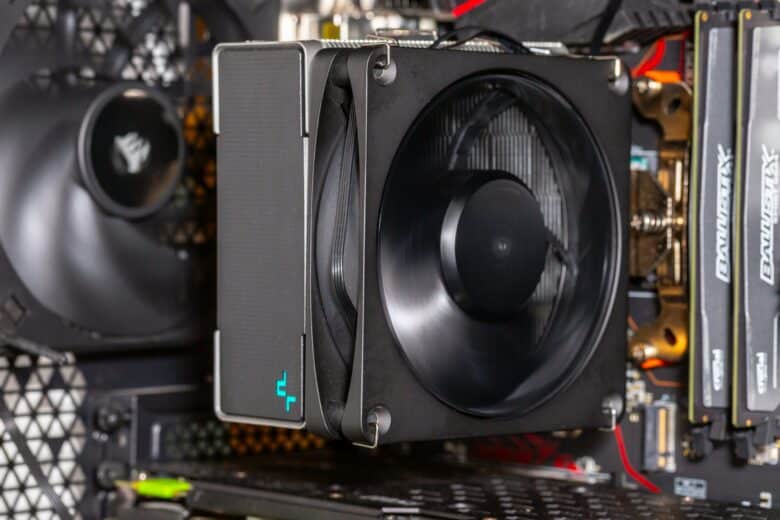
It also feels a little strange to mount the very heavy Alphacool APEX Stealth with the thin brackets on the air cooler for the test. The matt black coating didn’t really like the brackets either, so that slight shiny stripes were visible on the side. These don’t really catch the eye, but it’s still a shame.
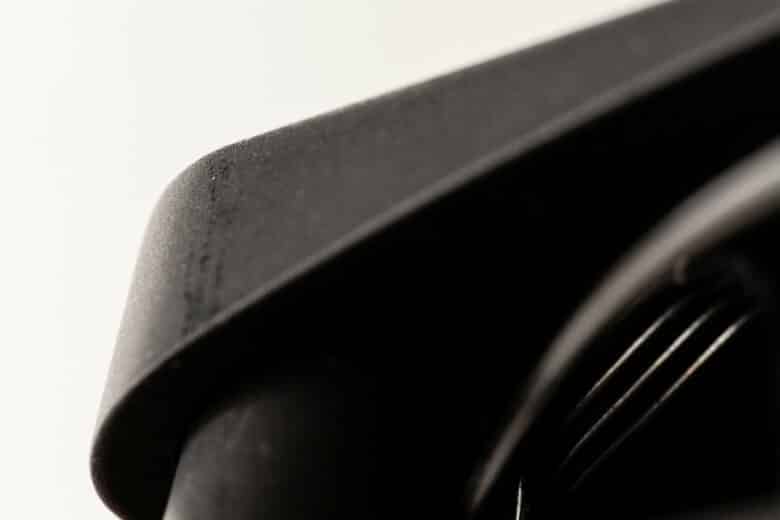
I would not recommend the Alphacool APEX Stealth for air coolers.
Conclusion
It’s not easy for me to come to a conclusion about the Alphacool APEX Stealth. The pure performance is good, but you shouldn’t expect miracles. For the given performance, these 120 mm fans are not cheap, but on the other hand, the metal parts are of course more expensive to produce. These components are also something special and simply look very impressive. So I have two conflicting views: The pure performance, the pure numbers and measurement results are such that you can get a higher performance for the same money or the same performance for less money. On the other hand, there is the emotional part. The Alphacool APEX Stealth simply looks solid, high-quality and stands out from the crowd. And the performance is still good, so you won’t notice any practical difference to the other fans in everyday use – as long as you’re not operating at the absolute limit.
Last but not least, although I tested the matt black fans, the gold or chrome-look fans also stand out visually and can create a very special design in the case, for which the matt black models are still too inconspicuous. Whichever way you look at it: The fans are something special without setting new performance records. Would I recommend them? That depends on the overall concept of the computer. Overall, the Alphacool APEX Stealth Metal Fan is a good fan. If you can spend the money and are looking for something special, you could be very satisfied with these fans. If you are looking for the absolute top performance to tickle out the last points in a benchmark game, you will have to look at other fans.
Alphacool APEX Stealth
Features
Workmanship
Noise level
Performance
91/100
The Alphacool APEX Stealth are high-quality, powerful 120 mm fans that stand out in particular thanks to their excellently crafted metal frame.


